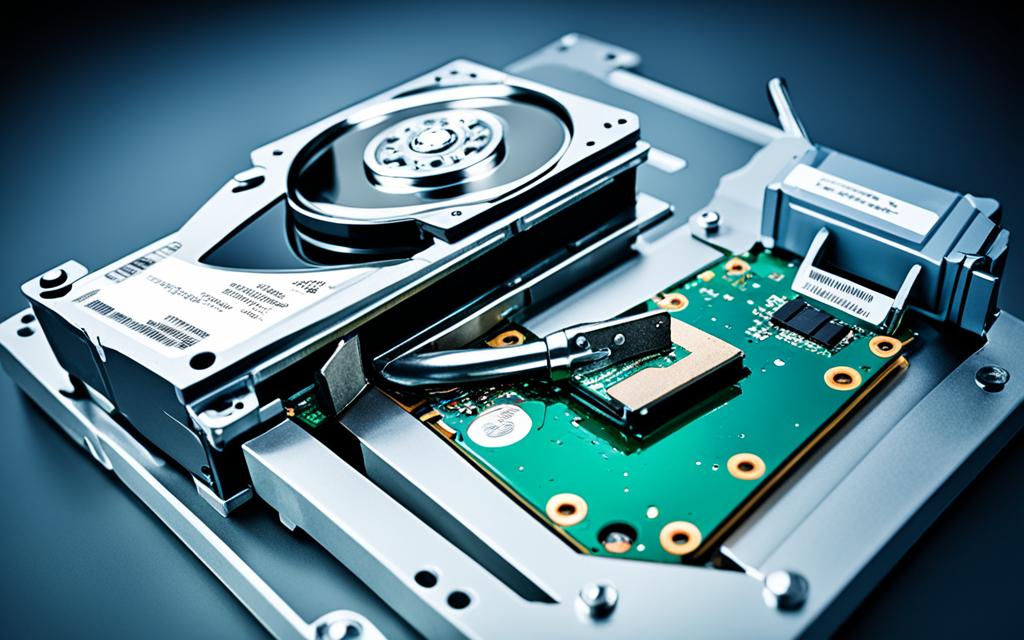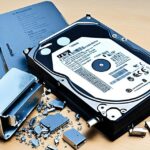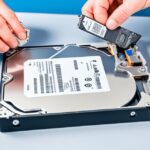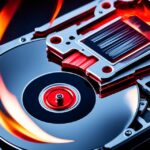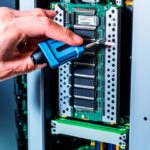Table of Contents
Removing an HDD partition may seem tough, but it’s key for better storage and system speed. Learning to delete a partition not only makes more space but helps you organise data better. But, remember, deleting it means all its data is gone forever. Most find it critical to back up important files first. This prevents losing your data1. In this article, we’ll show you how to get rid of an HDD partition. You can use the Settings app, Disk Management tool, Command Prompt, or PowerShell to do this.
Key Takeaways
- Understand what an HDD partition is before attempting removal.
- Back up critical data to prevent irreversible loss.
- Multiple tools are available for partition management.
- Deleting a partition can free up space for new or expanded partitions.
- Know that the entire data on the partition will be deleted.
- For Windows users, both Graphical User Interfaces and Command Lines provide options for partition deletion.
Understanding HDD Partitions
To manage your computer’s storage well, it’s key to grasp HDD partitions. An HDD partition is part of a hard drive that works alone. This lets users organise files in a way that suits them best.
What is an HDD Partition?
An HDD partition splits a hard drive into several parts. Every part can have its own file system. This makes it easier to handle data and can make your computer run better.
Why Would You Want to Remove a Partition?
Sometimes, you might need to delete a partition. Reasons include wanting more space or getting rid of a partition that was wrongly made. Removing these can help make your computer’s storage work better.
Tools like Windows Settings or Disk Management make deleting easy. This makes managing HDD partitions simpler when managing HDD partitions2.
| Reason for Deletion | Description |
|---|---|
| Consolidation of Space | Merging partitions can create more space. |
| Incorrect Partition Created | Getting rid of unwanted partitions keeps things tidy. |
| Optimisation of Storage Management | Having fewer partitions makes finding files easier. |
Knowing why partitions matter can help you manage storage better. Being aware of times when you should delete a partition lets you control your system better1.
How to Remove an HDD Partition Using the Settings App
Deleting an HDD partition is easy if you know how. The Settings app makes it simple to control disk partitions. Just a few steps let you remove an HDD partition using Windows Settings.
Step-by-Step Guide to Deleting via Settings
Start by opening the Storage settings on Windows. Here’s what to do next:
- Press Windows + I to open Windows Settings.
- Go to the System tab and find Storage.
- Look for Advanced Storage Settings and expand it.
- Choose the drive you want to edit.
- Find and select the option to delete the partition.
- Confirm your choice to remove the partition for good.
This process completely gets rid of the chosen partition.
Ensuring Data is Backed Up
It’s vital to backup data before you delete a partition. Save your important files somewhere else. This stops them from being lost.
Backing up is important for keeping your data safe. It means you can manage HDD partitions without worries.
How to Remove an HDD Partition Using the Disk Management Tool
The Disk Management tool helps you manage your computer’s partitions easily. It’s great for getting rid of partitions you don’t need anymore. This tool is not hard to use. It gives you a clear visual interface to handle the tasks more smoothly.
Accessing Disk Management
Opening the Disk Management tool is easy. Just press Win + R and type diskmgmt.msc in the Run dialog. Hit Enter. You will see a window that shows all connected drives and their partitions. Now, you can make the changes you want.
Steps to Delete a Partition
Deleting a partition using the tool is straightforward. First, right-click on the partition you want to get rid of. Then, choose the Delete Volume option. You’ll have to confirm your choice. Remember, this will erase all data on the partition, so make sure you’ve backed up your files.
The tool is very handy for those who like a visual way of managing partitions. It provides a clear view of how your storage is organized.
If you need more help on resetting your PC, check out this resource. It has loads of useful advice to help you reset your PC successfully.
| Step | Action | Notes |
|---|---|---|
| 1 | Open Disk Management | Use Win + R, type diskmgmt.msc |
| 2 | Right-click on the partition | Choose Delete Volume |
| 3 | Confirm the deletion | All data on the partition will be lost |
With the Disk Management tool, managing disk space becomes much easier. It’s important to understand how deleting a partition works to keep your computer running well342.
How to Remove an HDD Partition Through Command Prompt
Using Command Prompt is a smart way to handle your HDD partition. It lets you do tasks that require, say, deleting partitions without using the usual graphical path. Before you start deleting, make sure to back up any important data. Once gone with the delete partition command, there’s no getting it back.
Opening Command Prompt as Administrator
First off, find Command Prompt via the Start menu. It’s vital to run it with admin rights to properly manage partitions. Simply right-click on Command Prompt and choose ‘Run as Administrator’ for the needed permissions.
Executing Commands to Delete a Partition
With Command Prompt open, type ‘diskpart’ to bring up the Diskpart tool. Then, enter ‘list volume’ to see all your system’s partitions. This helps you spot the one you intend to delete. Next, use ‘select volume X’, swapping X with your target’s volume number. Finally, ‘delete volume’ gets rid of that partition for good. This way, managing your disk space is easy and direct, avoiding complicated menus.
Disk cleaning regularly and uninstalling properly boosts your system’s efficiency. Be careful with these commands; wrong moves mean losing data on your HDD3.
Using PowerShell to Remove an HDD Partition
PowerShell is a powerful tool for managing HDD partitions. It helps advanced users carry out complex commands for their storage. It’s important to run PowerShell with the right permissions to use it fully.
Running PowerShell with Admin Rights
To start using PowerShell for partition management, open it with admin rights. Search for PowerShell in your Start Menu. Then, right-click on the icon and choose ‘Run as administrator.’ This gives you the needed rights to change system settings and handle storage devices.
Commands for Deleting a Partition
With the correct permissions, you can use PowerShell to manage your HDD partition. Use the command Get-Volume to see all volumes. It shows you the active partitions. To remove one, use Remove-Partition -DriveLetter X, with ‘X’ being the partition’s drive letter. This way is simple and friendly for those new to command lines.
For deleting all data from a disk, the Clear-Disk cmdlet is useful. It has options like -Number, -ThrottleLimit, and -Confirm. Use the -RemoveData option to delete all data. The -ThrottleLimit option helps control many operations at once. Remember, OEM recovery partitions won’t clear without the -ForceOEM. Understanding these commands helps users manage their partitions well5
| Command | Description |
|---|---|
| Get-Volume | Lists all available volumes and their properties. |
| Remove-Partition -DriveLetter X | Deletes the specified partition identified by its drive letter. |
| Clear-Disk | Clears the disk’s data; conditional parameters allow customized operations. |
| -RemoveData | Mandatory to remove all data if active data volumes exist on the disk. |
| -ThrottleLimit | Sets the maximum number of concurrent operations during the execution of commands. |
| -ForceOEM | Required if you wish to clear OEM recovery partitions. |
Conclusion
In this article, we’ve given a thorough look at how to delete HDD partitions. We looked at methods like using the Settings app, Disk Management, Command Prompt, and PowerShell. Each way has its own benefit, making it easier for you to handle disk space. The method you choose depends on what you’re comfortable with. This makes sure managing your HDD is something you can do confidently.
Before you start deleting any partitions, it’s vital to back up your data. Without a backup, you might lose important files forever. This can be risky. If you’re looking for a simple way to handle partitions, consider using third-party software. A good option is EaseUS Partition Master. Our guide on removing partitions from an external hard drive can be found here4. It makes the process easier.
With the right tools, you can easily create or remove space on your HDD. Deleting unwanted partitions helps improve your drive’s performance. Whether you use built-in tools or special software, you have what you need. This guide helps you take charge of your HDD’s space and performance.
FAQ
What happens when I remove an HDD partition?
When you remove an HDD partition, all the data on that partition is gone forever. It’s very important to save any important files somewhere else before you do this.
How can I ensure my data is safe before deleting a partition?
Before deleting a partition, always back up your important data. You can use an external drive or cloud storage for this. Doing so protects your important information from being lost.
Is it possible to recover a deleted partition?
Recovering a deleted partition is tough. You can try using data recovery programs, but they might not get back all the lost data. This is why having backups is really important.
Are there any risks associated with deleting a partition?
Yes, the main risk is losing your data. Also, if you don’t remove partitions right, your computer might not work well anymore. This includes possibly losing the operating system if you delete the wrong files.
Can I delete a partition using the Disk Management tool?
Yes, you can! Just open the Disk Management tool on Windows. Then, right-click the partition you want to remove and choose “Delete Volume” to go ahead.
What if I don’t have administrative rights to delete a partition?
To delete a partition, you need to be an admin. If you’re having trouble, try using Command Prompt, PowerShell, or Disk Management as an admin.
What is the difference between using Command Prompt and PowerShell for partition management?
Command Prompt and PowerShell can do similar things. But, Command Prompt uses basic commands, and PowerShell can do more complex tasks because it has more advanced scripts.
How can I tell which partition to delete?
You can see all the partitions in Disk Management or Command Prompt. They show details like how big each one is and what format it’s in. Be very careful to pick the right one to avoid losing data you didn’t mean to.
Source Links
- https://www.techtarget.com/searchwindowsserver/tip/Using-Diskpart-to-create-extend-or-delete-a-disk-partition – Using Diskpart to create, delete, clean or extend disk partitions | TechTarget
- https://www.makeuseof.com/delete-drive-partition-windows/ – 4 Ways to Delete a Drive Partition on Windows
- https://www.diskpart.com/diskpart/delete-partition-4125.html – [Tutorial]: Diskpart Delete Partition on Windows 11, 10, 8, and 7
- https://www.easeus.com/partition-manager-software/unpartition-a-hard-drive.html – How to Unpartition a Hard Drive on Windows 11/10/8.1/8/7
- https://www.pdq.com/powershell/clear-disk/ – Clear-Disk – PowerShell Command | PDQ

